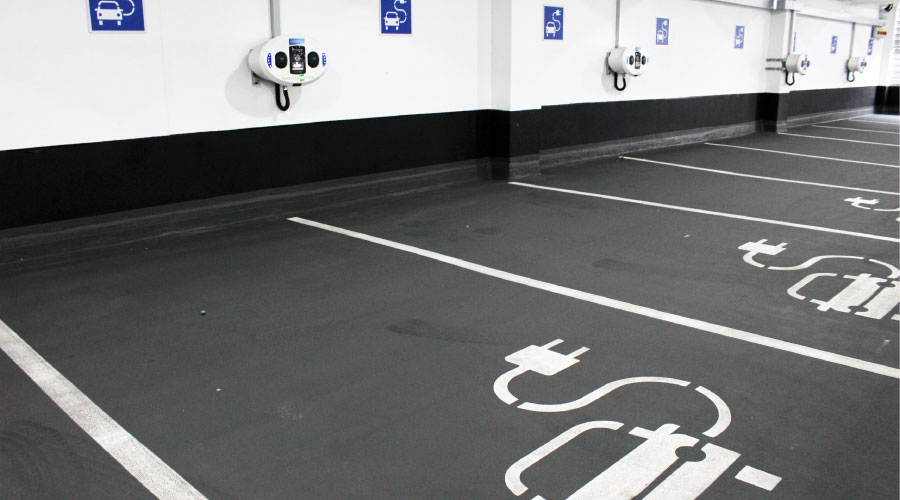How to Plan for Electric Vehicle Parking
From cost considerations to space planning, here are some strategies to help facility managers accommodate the growing need for EV charging and parking.
By Greg Zimmerman, Senior Contributing Editor
The ripple effects of any disruptive technology are often felt far and wide. Proactively preparing for these changes can be extremely advantageous for facility managers. One technology that is disrupting everything from leasing arrangements to design and construction to green building initiatives is electric vehicles.
It’s not an exaggeration to suggest that in 10-15 years, electric vehicles will be the norm, rather than the exception. How will buildings strategies shift to accommodate the need for more parking for EVs, more charging stations, and the potentially higher electricity demand that would come with more charging stations? How will leases be negotiated to accommodate both EVs and traditional parking? How will tenants or occupants be charged back (if they are) for electricity used to charge EVs? Or will EV charging be a perk of a lease for a Class A building?
The answers to these questions are something facility managers should consider now for future planning. Luckily, many experts are already working on these issues. FacilitiesNet recently talked with two such experts, Rex Hamre, national director, sustainability, project and development services for JLL; and Jay Wilson, vice president, sustainability, project and development services for JLL, about these EV issues and much more.
FacilitiesNet: In leasing arrangements, what are some best practices for handling EV parking? Are there certain numbers of EV spots? Would a lease specify a base amount of "free charging"? How would this work?
JLL: It is best practice to have allocated EV charging locations, and dedicated EV charging locations if you are an anchor tenant, and a plan for growth, especially if fleet support is needed.
A lease can specify free charging or monthly charging costs. However, cost per hour fees, even nominal amounts, are a key management tool to encourage appropriate and shared use of workplace charging amenities. This can help with demand management and ensure that tenant needs are met while optimizing capital installation and management costs. An advantageous agreement might be for a tenant’s employees to have the first two hours of charging be at cost plus a nominal overhead fee (i.e. less than $0.25 per kWh), then the cost steps up from there. Green leases should also specify details related to metering, data management and sharing. This is particularly important for tenants with large vehicle fleets that need to be accounted for carbon emissions reporting.
FacilitiesNet: Conventional wisdom seems to be that EV spots are given preferential treatment location-wise, for example, closer to the building. Why is this the case? Do you see this as a trend that'll continue as there are more EVs and therefore more EV charging required?
JLL: Many of the first workplace charging installations were completed in buildings targeting third-party certification, where credit is given for giving priority parking to alternative fuel vehicles. This trend may continue, though efficient location of infrastructure will become increasingly important as EV charging implementation scales across the industry. The most efficient locations would include those that are close to electrical infrastructure or are stacked (in a garage) to minimize cabling costs.
FacilitiesNet: Does including more EV charging stations in a building help or hurt an organization's environmental goals? How do facility managers balance this?
JLL: The priority is to achieve the right balance between the number of chargers to meet demand while minimizing upfront capital costs and efficiently managing operating costs.
Offering EV charging helps an organization’s environmental goals but is also a visible amenity that can increase lease-up rates, improve employee retention, and support electrified vehicle fleets. For an organization with fleet vehicles, EV charging reduces your scope 1 carbon emissions. For an organization with workplace charging for privately owned vehicles, those leveraging EV charging reduces scope 3 emissions.
FacilitiesNet: How much does the continued trend toward hybrid work plan into EV charging planning? How much does it affect planning for the number of spaces?
JLL: Demand is a key consideration when planning future investment into site EV charging. There are many factors that should be considered when determining demand, including occupancy, proximity to other chargers and their cost, and overall EV market adoption.
Greg Zimmerman is senior contributor editor for the facility group, which including FacilitiesNet.com and Building Operating Management magazine. He has more than 19 years’ experience writing about facility issues.
Related Topics:












